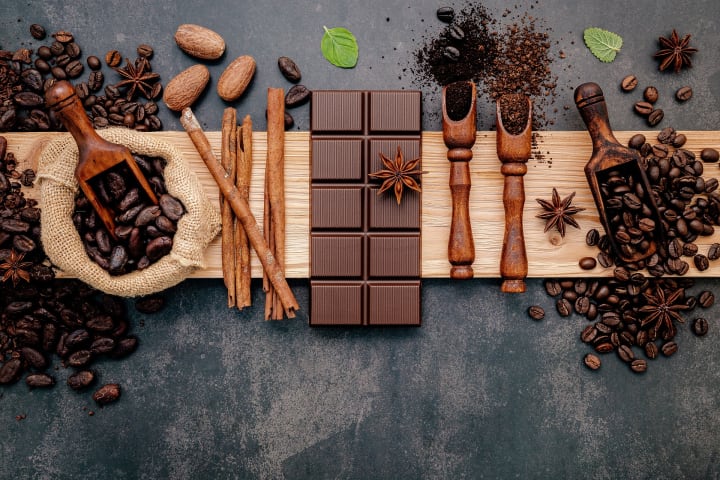Unwrapping the Secrets of Chocolate
Exploring the Science Behind the World's Favorite Confection

Chocolate is one of the most beloved treats in the world, enjoyed in many different forms, from candy bars to hot cocoa. But what makes chocolate so irresistible? And what is the science behind it?
To understand the science behind chocolate, we first need to look at the basic ingredients. Chocolate is made from cocoa beans, which are harvested from the cacao tree. The beans are roasted and ground into a paste, which is then mixed with sugar, milk, and other ingredients to create the final product.
The main active ingredient in chocolate is a compound called theobromine, which belongs to a group of chemicals called methylxanthines. Theobromine is similar to caffeine and has similar effects on the body, including increased heart rate and blood pressure. However, theobromine is milder than caffeine and is not addictive.
Another important compound in chocolate is phenylethylamine, which is a natural mood enhancer. When we eat chocolate, phenylethylamine is released in our brains, producing feelings of pleasure and happiness. This is why chocolate is often associated with romantic gestures and celebrations.

But the science behind chocolate is not just about the chemicals in the confection. Chocolate is also a complex mixture of fats, sugars, and proteins that interact with each other in unique ways. For example, the fat in chocolate can change the way the sugar crystals form, leading to differences in texture and flavor.
The type of chocolate also plays a role in its composition and taste. Dark chocolate, for example, contains a higher percentage of cocoa solids and less sugar than milk chocolate. This gives it a more intense flavor and a slightly bitter taste. White chocolate, on the other hand, contains no cocoa solids and is made from cocoa butter, sugar, and milk. This gives it a creamy, sweet flavor that is less intense than dark chocolate.

The processing of chocolate also affects its flavor and texture. One important step in the processing of chocolate is conching, which involves mixing the chocolate with a liquid to smooth out any rough particles and improve its texture. The longer the chocolate is conched, the smoother and creamier it will be.
Another important process in chocolate production is tempering, which involves carefully heating and cooling the chocolate to produce a shiny, stable product. Tempering is essential for creating chocolate that is easy to handle and has a smooth, glossy finish.
The science behind chocolate has also led to many innovative uses for confection. For example, chocolate has been used in medicine as a treatment for coughs and diarrhea. The flavonoids in chocolate are believed to have anti-inflammatory properties that can help alleviate these symptoms.
Chocolate has also been studied for its potential health benefits. Dark chocolate, in particular, has been found to contain antioxidants that may help reduce the risk of heart disease and stroke. Some studies have even suggested that chocolate may have a positive effect on brain function and memory.
But despite its potential health benefits, chocolate is still a high-calorie treat that should be enjoyed in moderation. Too much chocolate can lead to weight gain and other health problems, so it is important to consume it in moderation as part of a balanced diet.

In conclusion, the science behind chocolate is a fascinating and complex subject that involves chemistry, biology, and even physics. From its basic ingredients to its unique flavor and texture, chocolate is a confection that has captured the hearts and taste buds of people around the world. And while we may not fully understand all of the science behind chocolate, we can certainly enjoy it as a delicious and indulgent treat.
About the Creator
Gopikrishna
I’m a man roaming the streets of Tamil Nadu with millions of dreams in mind. I hope here my blog will bring joy to readers. So motivate me by hitting the like and subscribe buttons also anyone can interact with me on a comment session.
Reader insights
Outstanding
Excellent work. Looking forward to reading more!
Top insights
On-point and relevant
Writing reflected the title & theme
Easy to read and follow
Well-structured & engaging content
Excellent storytelling
Original narrative & well developed characters
Compelling and original writing
Creative use of language & vocab
Heartfelt and relatable
The story invoked strong personal emotions
Masterful proofreading
Zero grammar & spelling mistakes
Expert insights and opinions
Arguments were carefully researched and presented






Comments (1)
As a chocolate lover, I found this article to be incredibly informative and fascinating! I never knew that theobromine and phenylethylamine were the key compounds responsible for the delicious and addictive flavor of chocolate. It was also interesting to learn about the different types of chocolate and the role that processing plays in creating the perfect texture and flavor. The section on the potential health benefits of dark chocolate was particularly eye-opening. Overall, this article has given me a newfound appreciation for the science behind chocolate and I will be enjoying my favorite treat with a new perspective from now on!